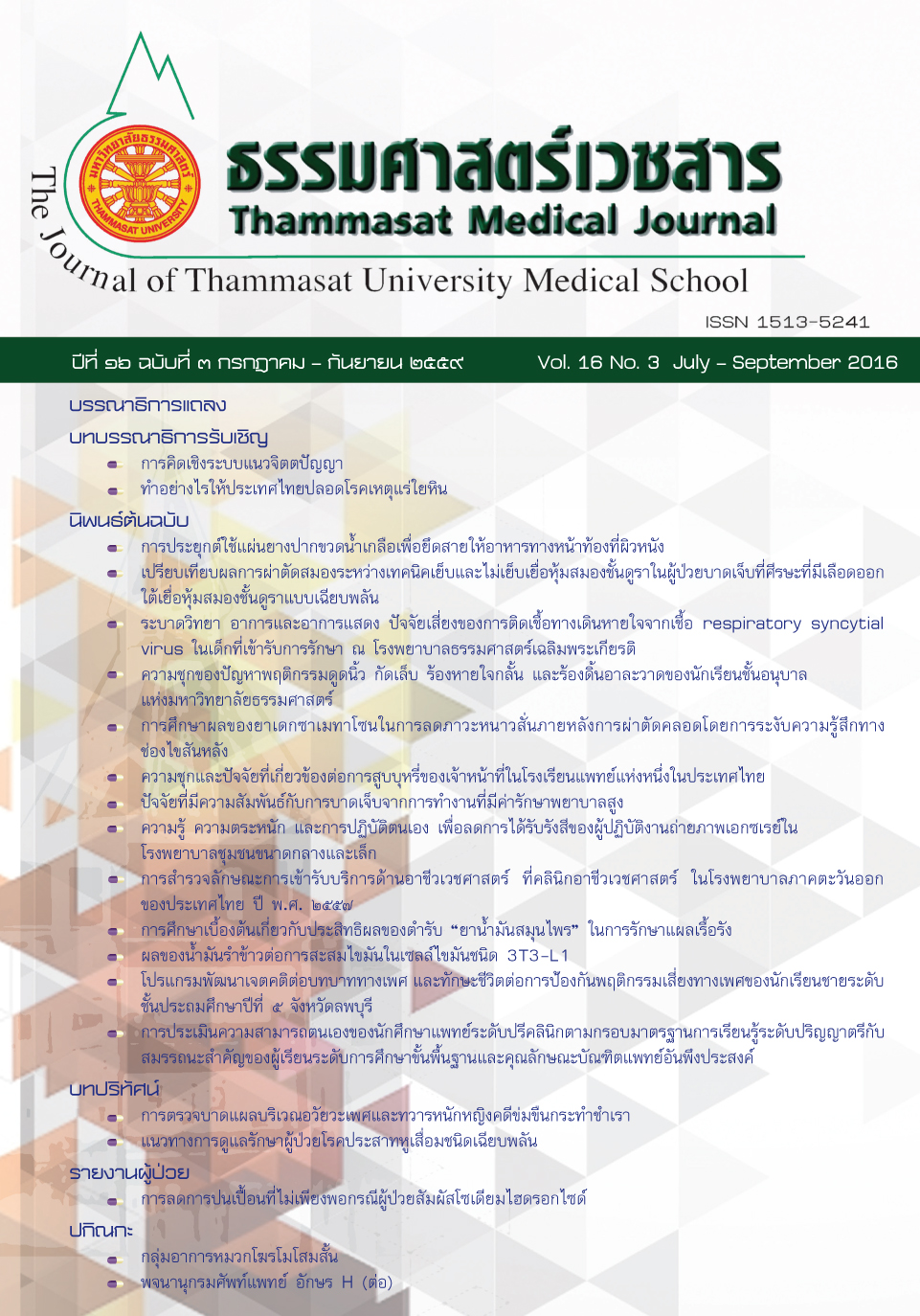Prevalence of thumb sucking, nail biting, breath-holding spells and temper tantrums in the kindergarten of Thammasat university
Keywords:
Thumb sucking, Nail biting, Breath-holding spells, Temper tantrums, Preschool-ageAbstract
Introduction: Thumb sucking, nail biting, breath-holding spells and temper tantrums are the most common problem in the preschool children. These problems impact on physical and mental health of the children and their family. In case of inappropriate caring, its may be cause of negative effect on physical and mental health of the children in the future. Objective was to study the prevalence and parental response to behavioral problems: thumb sucking, nail biting, breath-holding spells and temper tantrums in the kindergarten of Thammasat university.
Method: It was a descriptive cross sectional study. Data collection was conducted by answering questionnaires from the parents of children at the kindergarten of Thammasat university.
Result: Three hundred thirty seven children (77%) of 438 children in the kindergarten of Thammasat university answered the questionnaire, mean age 4 years 6 months ± 1 year 6 months (3 years - 6 years 6 months), 187 male (55.5%). Main caretakers were parents (79.8%) and most of questionnaire responders were mothers (73.3%). 171 children had behavioral problems (50.7%) 34.7%, 13.9%, 1.8% and 0.3 % of the responders had 1, 2, 3 and 4 problems, respectively. Prevalence of temper tantrums, nail biting, thumb sucking and breath holding spell were 33.5%, 17.8%, 15.4% and 2.4%, respectively. The frequencies of behavioral problems were below 4 days/week. The most common technique of caregiver’s response to temper tantrums (57.5%) and thumb sucking (40.4%) was distraction. For nail biting, the most common technique was “pull the finger out instantly” (45%) and for breath-holding spells was ignorance (25%).
Discussion and Conclusion: Thumb sucking, nail biting, breath-holding spells and temper tantrums were the most common behavioral problems in preschool age. A half of preschool children had some behavioral problem(s). The caretakers used many proper and improper response techniques.
บทนำ: ปัญหาพฤติกรรมดูดนิ้ว กัดเล็บ ร้องหายใจกลั้น และร้องดิ้นอาละวาดเป็นพฤติกรรมที่พบได้บ่อยในเด็กวัยก่อนเรียน ซึ่งส่งผลกระทบต่อทั้งร่างกายและจิตใจของเด็กโดยตรงและผู้คนรอบข้าง หากพฤติกรรมดังกล่าวไม่ได้รับการแก้ไขที่เหมาะสมอาจส่งผลกระทบต่อเด็กทั้งทางร่างกายและจิตใจในอนาคตได้ การศึกษานี้มีวัตถุประสงค์ เพื่อศึกษาความชุกและการตอบสนองของผู้ปกครองกับปัญหาพฤติกรรมดูดนิ้ว กัดเล็บ ร้องหายใจกลั้น และร้องดิ้นอาละวาด ของนักเรียนอนุบาลแห่งมหาวิทยาลัยธรรมศาสตร์
วิธีการศึกษา: การวิจัยแบบพรรณนา (descriptive study) แบบตัดขวาง ณ ช่วงเวลาหนึ่ง (cross-sectional study) โดยใช้แบบสอบถามให้ผู้ปกครองตอบกลับ
ผลการศึกษา: จำนวนเด็กนักเรียนทั้งหมด ๔๓๘ คน ผู้ปกครองยินยอมเข้าร่วมการศึกษา ๓๓๗ คน (ร้อยละ ๗๗) อายุเด็กเฉลี่ย ๔ ปี ๖ เดือน + ๑ ปี ๖ เดือน (๓ ปี - ๖ ปี ๖ เดือน) เพศชาย ๑๘๗ คน (ร้อยละ ๕๕.๕) บิดามารดาเป็นผู้เลี้ยงดูหลัก ๒๖๙ คน (ร้อยละ ๗๙.๘) และผู้ตอบแบบสอบถามส่วนใหญ่เป็นมารดา ๒๔๗ คน (ร้อยละ ๗๓.๓) พบความชุกของเด็กที่มีปัญหาพฤติกรรมทั้งหมด ๑๗๑ คน (ร้อยละ ๕๐.๗) โดยเด็กที่มีปัญหาพฤติกรรม ๑, ๒, ๓ และ ๔ อย่างพบ ร้อยละ ๓๔.๗, ๑๓.๙, ๑.๘ และ ๐.๓ ตามลำดับ ความชุกของพฤติกรรมร้องดิ้น อาละวาด กัดเล็บ ดูดนิ้ว และร้องหายใจกลั้น ร้อยละ ๓๓.๕, ๑๗.๘, ๑๕.๔ และ ๒.๔ ตามลำดับ ความถี่ ส่วนใหญ่ของทุกปัญหาพฤติกรรม คือ น้อยกว่า ๔ วันต่อสัปดาห์ การตอบสนองที่พบมากที่สุดของผู้ปกครอง คือ การเบี่ยงเบนความสนใจ ต่อปัญหาพฤติกรรมร้องดิ้นอาละวาด และดูดนิ้ว คิดเป็นร้อยละ ๕๗.๕ และ ๔๐.๔ ตามลำดับ การดึงนิ้วออกทันทีในปัญหาพฤติกรรมกัดเล็บ พบร้อยละ ๔๕.๐ และการเพิกเฉยต่อปัญหาพฤติกรรมร้องหายใจกลั้น พบร้อยละ ๒๕
วิจารณ์ และสรุปผลการศึกษา: ร้อยละ ๕๐ ของเด็กวัยก่อนเรียนมีปัญหาพฤติกรรมอย่างใดอย่างหนึ่ง ประมาณ ๑ ใน ๓ พบมีปัญหาพฤติกรรมมากกว่า ๑ อย่าง โดยพบความชุกของปัญหาพฤติกรรมร้องดิ้นอาละวาด กัดเล็บ ดูดนิ้ว และร้องหายใจกลั้นตามลำดับจากมากไปหาน้อย การตอบสนองของผู้ปกครองขณะเกิดปัญหาพฤติกรรมของเด็ก มีทั้งเหมาะสมและไม่เหมาะสม



